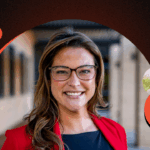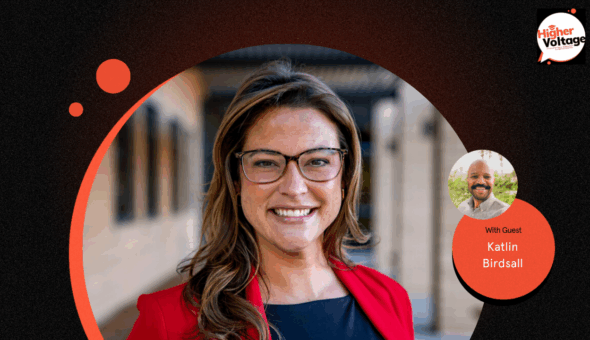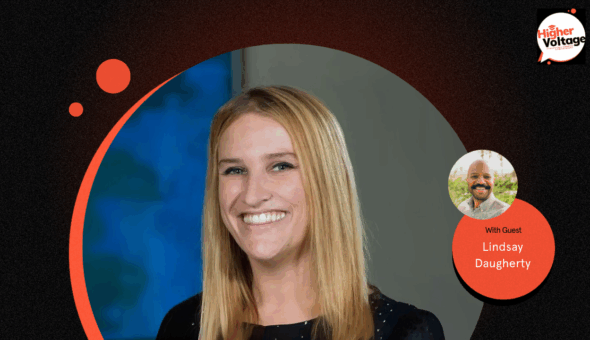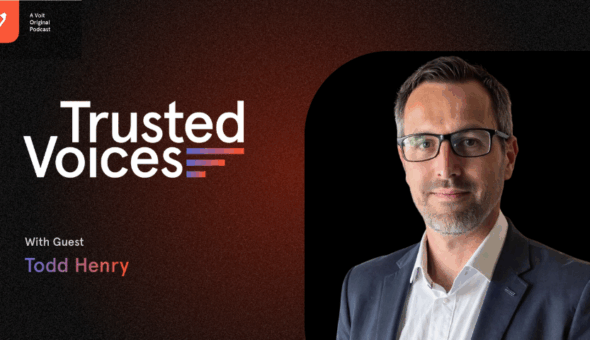Just weeks after SCOTUS handed down the decision in Students for Fair Admissions, Inc. v. President and Fellows of Harvard College that effectively ends race-conscious admissions, higher ed leaders are still attempting to find a new path that will ensure fair and equitable access to secondary education.
Natasha Warikoo, Lenore Stern Professor in the Social Sciences Department of Sociology at Tufts University, rejoins host Kevin Tyler to discuss the recent SCOTUS decision and how institutions may move forward in the post-affirmative action era.
Show Notes
- How The End of Affirmative Action Reroutes the Talent Pipeline
- After Supreme Court Ruling, DEI Work Gets More Challenging and Crucial, Experts Say
- As Affirmative Action Ends, HBCU’s Wait or Plan for the Fallout
Recorded Monday, July 17, 2023
Read the full transcript
Kevin Tyler:
Higher voltage is brought to you by eCity Interactive. For over 20 years, eCity Interactive has created websites and digital marketing strategies and solutions for colleges and universities that deliver results and exceed expectations. Their latest offerings to higher ed clients include enrollment funnel diagnostics and enrollment support services that efficiently attract and engage potential applicants with results you have to see for yourself. To learn more, visit ecityinteractive.com.
Hello and welcome to Higher Voltage, a podcast about higher education that explores what’s working, what’s not, and what needs to change in higher ed marketing and administration. I’m your host, Kevin Tyler. Welcome back to Higher Voltage. I am Kevin Tyler, joined once again by Natasha Warikoo. Natasha is the Stern professor in the humanities and social sciences Department of Sociology at Tufts University, a former Guggenheim fellow and high school teacher.
She’s written four books: Race at the Top: Asian Americans and Whites in Pursuit of the American Dream in Suburban Schools; Is Affirmative Action Fair: The Myth of Equity in College Admissions; the Diversity Bargain: And Other Dilemmas of Race, Admissions and Meritocracy at Elite Universities; and Balancing Acts: Youth Culture in the Global City, her first book.
You might recall, Natasha joining us a couple of months ago before the Supreme Court decision was announced around affirmative action in higher ed. We wanted to bring her back for a follow-up conversation about some of the details of the decision, some perspectives that she might have about what higher ed might look like in the future and all sorts of other things.
Natasha, welcome back to Higher Voltage.
Natasha Warikoo:
Great to be back.
Kevin Tyler:
So for those who might need a primer on the decision, I’m wondering if you might be able to give us an overview of what the Supreme Court decided in their decision around affirmative action.
Natasha Warikoo:
Sure. So in this decision, which in some ways was expected, but in others is kind of astonishing when you think about the precedent that it overturns. There have been multiple cases that made it to the US Supreme Court that confirmed the legality of affirmative action and in this case, obviously it’s a changed court. They overturned those precedents. And they basically said that race-conscious admissions in higher education is no longer allowed. So it’s important not to take it too much further than that. And they said that diversity is a good goal, but in their view it was too nebulous.
Again, that was surprising to me because of all the evidence that exists about the benefits of diversity on campus, but the court said, “Well, because you’re not giving us a number or a system, then that’s not allowed.” They also said that the way that race was taken into consideration was not narrowly tailored enough, and so they said, “You can take into consideration a student’s experiences with racial discrimination if they talk about it in their essay. A student can talk about their ethnic heritage and how that is a big part of their identity and who they are, but you can’t just have something like a checkbox.”
And so that was their decision and they did make an exception. This was kind of a strange footnote for the military academies and they said, “Well, we can see the benefits to the military of racial diversity and the importance of racial diversity.”
That was kind of surprising to me because there’s evidence from the military and the woman from the military spoke very eloquently about the importance of diversity for the military for national security, but why that didn’t apply to other domains in the United States was kind of a mystery to me, but that’s what they said.
Kevin Tyler:
So I love that you brought up the military school example because that was actually my next question. Some of the more surprising points from the decision and people have surmised all the different reasons why they may have left out military schools from a decision like this. I will not run through those opinions because you can find those at other places, but it is an interesting and compelling exclusion from the decision.
I’m wondering if there were any other points from the decision that you found to be surprising understanding, again, I want to remind our listeners that Natasha is not a lawyer or an attorney but knows these parts of the world very well. So I was wondering if there was anything surprising to you?
Natasha Warikoo:
Yeah, thanks for saying that because I always preface my comments by saying I’m not a lawyer. One thing that I was pleasantly surprised about was that in his decision, Justice Roberts made it a point to say that this does not preclude knowing someone’s race or ethnicity in the application process and gave the example that I talked about earlier. They really are sort of, as Justice Kagan said it in the hearings, you’re kind of slicing the bologna very thinly. They just don’t want you to take into consideration race [inaudible 00:04:57] race. But if it’s race in as much as it shapes where you live or your lived experiences, that is in fact even welcome according to them.
Kevin Tyler:
Got you. I think that’s an important point as well. I’m also curious around, and this is kind of off the cuff kind of question, but it feels like race is only being described for people who are not white. And so the legacy piece and these other ways that speak to race but not using the word race were not really discussed or addressed in the decision. Can you speak a bit more around the other ways or the points of admission that were brought up so often in the hearings around legacy donor, the other two, there are four groups of students that will not be affected by some of this?
Natasha Warikoo:
Yeah, it’s interesting. I think the bottom line is that this court has very much taken on this colorblindness approach that the plaintiffs were advocating. And so they say that we cannot look at race as a kind of proxy for all of these other things.
Justice Jackson said this, it’s a sort of let them eat cake kind of response because clearly we have so much evidence to show that race does play a role in our lived experience, in our social life in the United States today is in as much as we don’t want it to. No one thinks that that’s a good thing, but the reality is different from what the ideal is.
And so I always found that odd in the hearing when the more conservative justices kept bringing up legacy admissions and athletics and all of these things. So let me just be clear, I don’t support legacy admissions, I don’t support admission for people for high net worth donors, but there’s no legal basis on which you could attack those policies.
And that is because this is the ultimate irony of this case, that race-conscious admissions was attacked because of these laws that we have that specifically protect vulnerable populations, specifically passed in the aftermath of slavery in this country, the 14th Amendment, the Civil Rights Act, just end of legal segregation. These were laws designed to protect African-Americans, and so race is a protected category because of that. And so the irony is that this policy that’s trying to make a dent in the adverse impact created by slavery and segregation, it has been attacked through those same laws, but there is no law that treats class as a special category. So colleges are allowed to privilege people who have more money. They’re allowed to say, “You know what? We don’t have any more financial aid money. We can’t admit you because you can’t afford it, and we’ve already used up all our financial aid dollars.” They are allowed to say, “Your parent went here at a time, or your grandfather went here at a time when this university did not allow black students.” They’re allowed to do that. And so that’s the sort of cruel irony I think of this decision.
Ketanji Brown Jackson talked about this in the hearing. She said, “Basically you’re allowing someone who is a legacy who’s five generations of going to UNC, most of which were at a time when black people are not allowed to go to UNC and it was a state funded school. But that is allowed, but someone whose family has been five generations in North Carolina but whose ancestors were not allowed to go to UNC and calling on that is not allowed.” And so it’s so problematic, but that is the way that the law is being used in this case.
Kevin Tyler:
Justice Brown Jackson had a lot of really great quotes in her dissent, one of which being like while racism doesn’t exist in the court, it does in real life or however that quote went. And it was speaking to creating laws for the way the world is and not the way that you think that the world should be. And I think that was a really interesting point to raise at a moment like this, because we have all of these other things happening around higher ed that are influencing who gets in.
So we have the student loan debt that was rejected by the Supreme Court. We have this that’s been rejected by the Supreme Court and so it’s starting to look like higher ed is reserved for a certain sect of people, which it was founded that way. And so it’s not that far of a stretch to come to that conclusion. But I’m curious what we might learn in this new era of higher ed admissions since California banned Affirmative Action back in the mid-90s. Are there any cautionary tales that the rest of the country might be able to learn from a state like California who’s already banned affirmative action?
Natasha Warikoo:
Well, I’ll start with a positive and then I’ll tell you what I think we can learn, which I’m not as optimistic about from places like California.
California spent half a billion dollars over the last 20-something years trying to increase access to the UC system. They increased outreach programs. They focused much more on holistic admissions, so less quantified. They went moved away from the SAT, which means you need a much more sort of broader look at these applicants. You need to train your admissions officers to be able to look at people in the context of the opportunities that they’ve had. They created bridge programs, they spent a lot of resources, and this is a time, by the way, since the 1980s when state funding for higher education has declined precipitously. So the UC system has been defunded and they’re spending all this money trying to increase… And still, the percentage of black and Latino students on particularly the highest status colleges, Berkeley, UCLA, have not come back to pre-ban levels and they don’t match the percentage of young people who are black or Latino. Over half of young people in California today are Latino.
And so this like a Herculean effort with one hand tied behind their back, that’s how I think about it. And I think that’s what leaders are going to do. Most leaders in higher education are committed to diversity, but this makes it a lot harder for them. And most colleges have been doing a lot of these things already to the extent that they can in terms of outreach, in terms of looking holistically, in terms of moving away from the SAT.
Do I think they can do more? Absolutely. Increasing financial aid, but I think the financial aid thing is a funny thing because where is that money going to come from? And that’s an important question that I think is not being raised enough. And so I think those are the kinds of things that colleges can and will and already are trying to do even more of. And I’m a little pessimistic about what they’ll be able to accomplish with this ban on race-conscious admissions in place.
Kevin Tyler:
Do you think that there are any approaches that won’t require an influx of cash that might help even some of the playing field a little bit maybe?
Natasha Warikoo:
I think more broadly rethinking how we consider students instead of thinking very narrowly about, “Okay, who’s the highest achievers in the academic realm and the extracurricular realm and athletics,” rethinking that and saying, “Well, let’s try to imagine what our goals are. If we are,” let’s take Berkeley, “We are part of the University of California system. Our remit is in part to the State of California, to the people of California, to the youth of California. Who do we need to educate in order to fulfill that mission? And what kinds of roles do we ideally want our graduates to play in society?”
And so rather than thinking very narrowly in terms of achievement and quote, unquote, “who deserves this kind of education,” thinking more broadly about, “Where can we have the biggest impact in the world and what does that look like? And how can we admit students?” And that, I think, really broadens who needs to be on your campus. And it might also mean that there are some students who haven’t had the same educational opportunities who you then need to provide a lot more academic support for and figuring out how to do that. Now that does take money.
Kevin Tyler:
Right.
Natasha Warikoo:
But I think it’s money well spent.
Kevin Tyler:
I think it’s interesting. I think in reading the articles of what schools are looking to do from geographic recruitment, zip code searches, et cetera, obviously we have a history of redlining in this country, so those parts might come into play here, but I’m so curious about what happens next. I just can’t imagine what’s going to happen next. And people have posited all these notions about what’s going to happen with HBCUs, historically black colleges and universities, and what kind of impact it will have, positive or negative, on that sector of the higher ed landscape.
Natasha Warikoo:
Yeah, HBCUs are already seeing higher applications in the last few years. I think that’s going to increase. I hope that people with deep pockets are going to fund HBCUs more than in the past instead of looking to the same elite universities that maybe they have a tie to that already are incredibly resource-rich, kind of looking at, “Well, what about I give that big donation to University of California or University of Michigan or this community college in my community or the HBCU that is down the line?” And I think universities also should be thinking about this like can they form partnerships with community colleges?
One thing I didn’t mention earlier, the University of California does really well is have a transfer system from the community colleges. So I don’t remember what the [inaudible 00:14:45]… You get a certain GPA and you can get automatically admissioned to one of the UCs. And I think that’s a really powerful engine for social mobility and it ties the resources to those universities. Think about Stanford, not just like Berkeley. What can Stanford do? How can they partner with the community college system in California? Or how can Harvard partner with the community colleges in Massachusetts to broaden who comes to these places and is able to benefit from them and then also contribute to our shared society.
Kevin Tyler:
Right. I think one important point to note, especially considering HBCUs is that the influx of applications, while I think is a wonderful development in the trajectory of HBCUs, very few are built to accommodate an influx of students, like the bodies and all the things that they bring. And so these campuses are not set up for that kind of success. And so yes, I agree with those gifts are going to really help HBCUs kind of get up to speed in terms of facilities, modernization, et cetera. I’m curious about your thoughts on some of the ancillary, maybe tertiary impacts that this decision might have on areas outside of higher ed. I think specifically, or up first, I think what comes to mind is workforce and what that might look like as a result of these decisions.
Natasha Warikoo:
Well, again, I’m not a lawyer, but the civil rights lawyers I’ve talked to have really emphasized that this decision is only about higher education admissions and should only be read in the context of race-conscious higher education admissions. And in fact, you actually can be race-conscious. You just can’t have, again, just like a checkbox and use that as part of your admissions process.
So it’s important to read this decision very narrowly and not extrapolate. Because, of course, what students for fair admissions want is for universities, organizations, employers to back off of anything race-conscious. That is their goal. Their goal is to end DEI programming, to end any kind of consideration of race in hiring to all of these efforts. There’s an attack on all of these efforts to promote racial justice and racial equity. And I think it’s important not to follow that logic and go down that line. So I don’t think this has anything to do with employment. Do I think that there are going to be more lawsuits? I do, but I think, “Don’t concede those lawsuits before they happen.” And so I think it’s really important not to play into that logic.
Kevin Tyler:
So we covered the HBCU sector of the industry. One of the things I’ve been thinking about specifically is the HSI designation that exists in higher ed and that threshold of 25% Hispanic, Latinx, Latina, Latino students that you have to reach in order to get an HSI designation. What happens to something like that in this new, no affirmative action era?
Natasha Warikoo:
Again, I think that’s still legal. This decision says nothing about the HSI designation, it says nothing about federal funds for Hispanic-serving institutions, and so the decision is about race conscious admissions, which is very different than designating certain institutions to get this funding. And HSIs, like HBCUs, and our big state universities, and our community colleges do amazing work in terms of when we think about social mobility. And so I would hate for people to think that this has any bearing on those institutions. I don’t think it does.
Kevin Tyler:
That’s good to know. So again, another personal conversation piece. So in order to get the designation, you have to know who was Latino coming in.
Natasha Warikoo:
Yeah, you’re allowed to know who your students’ race, you’re allowed to ask about race, certainly when students are coming. And there is this question, and Edward Bloom actually just sent this letter to a bunch of colleges saying you can’t collect race data. But this decision says you cannot consider race at the admissions process and you can’t use race to make a decision. You can’t say, “Oh, this person is black, this person is white, they’re exactly the same because of this,” which is kind of ludicrous anyway. That’s not a thing. But okay, you can’t use that to make a decision.
It does not say that students can still check a box and then that box is hidden, and the common app has actually talked about this, that they are going to create a mechanism by which students can mark their race, but it won’t be visible to the admissions office. And then once you’ve admitted your class, you can then see what percentage you have of each race. So you can absolutely know what your student’s race is. You can continue to collect race data, you just can’t use it as part of the admissions process.
Kevin Tyler:
I think that’s really important. Thank you for sharing that.
Okay, what else from this decision should people know that might not be covered in some of the big, splashy headlines that we’ve been seeing lately? I think that when decisions like this come out, the low-hanging fruit is the one that you hear most about, but there are a lot of other very important pieces that people should be paying attention to. Are there a couple of others that you can share from this decision?
Natasha Warikoo:
My main kind of worry, so I’ll just repeat it again, is that people read too much into this decision. So this has no bearing on whether you can collect race data in general, it has no bearing on other areas in terms of the workforce or selection, you can still have student centers that are identity-based DEIJ programming and those are important institutions in American society and we should defend those and we’ll leave it up to the civil rights lawyers to make sure they defend them if they get attacked.
I think the other thing that maybe we haven’t talked about is this question of Asian Americans. In the decision, there was this sort of funny equation of plus factor being the same as a negative factor that, “Well, if you are looking at race positively for underrepresented groups, then that’s inherently a negative on quote, unquote, ‘healthily represented groups.’”
I found that problematic, because I know that this case at Harvard involved Asian Americans, although there were no Asian Americans who testified or were named in this case, but it was supposedly on behalf of Asian Americans. And certainly there are some Asian Americans who supported that case. But this question of is there discrimination towards Asian Americans, I think, is a separate question from race-conscious admissions in a positive way. You cannot look at someone and say, well, “We have too many Asian Americans,” and whatever. But there was no evidence in this case that that’s what was happening, and in fact, there’s very healthy representation of Asian Americans on the Harvard campus. Now that doesn’t mean there’s no discrimination or stereotyping, but when I looked at the evidence, I didn’t see anything that made me wonder, which was interesting. Because before the case, I always thought, “That’s a little weird. Why are their SAT scores higher?” And when you look at the data, it becomes a little more clear.
So I was surprised that having all of this data come out at the Harvard trial, that they still mentioned this question of discrimination and that they equated it to race as a plus factor, not as a negative factor, because they are, of course, it’s zero-sum, but it’s a different kind of thing. And the university was using race as a plus factor for underrepresented groups, but it didn’t seem to be using it as a negative for others, for Asian-Americans or for whites. So I think that’s an important distinction as well. And that was a kind of troubling part of that decision as well.
Kevin Tyler:
Yeah.
So the last time we chatted, I asked you about what the future of higher ed might look like in your estimation, and while many people in the higher ed space kind of anticipated the decision to plan the way that it did, does this change what your outlook on higher ed might be moving forward or is it still kind of the same?
Natasha Warikoo:
I think, in some ways, this decision combined with the student loan decision, and I’m hopeful that the federal government is going to find another way to allow for student debt relief, I do think the financing of our higher education system is really kind of broken.
Affirmative Action only applies to a very small percentage of our higher education institutions because it’s only two to 300 colleges that are that selective that it would even be an issue. Most colleges are open-access, most college students are commuters, they’re part-time, they’re over 22, and so it’s easy to forget that when there’s so much attention to this policy. But also, those institutions, they are spending so much more per pupil than our community colleges, than even ours, like big state school, flagship state colleges. And those are the places, the state schools, the community colleges where we’re seeing kind of mobility.
Now, mobility is not the only thing that colleges are trying to do, but it’s an important goal in our society when a higher education has become like K-12 in that it’s kind of necessary to have a decent income to have a good life. We kind of think of it as becoming increasingly like the baseline in the way that a high school diploma was a baseline.
And if it is, then it should be publicly funded the way that K-12 education is publicly funded, but that’s not what we do in the United States. And we have been increasing, perhaps not enough, but we have been increasing funding for K-12 education. We need to be doing the same for public higher education and we’ve gone in the opposite direction.
At the same time as, because of these endowments and the way the stock market has run, these private institutions have accrued more and more resources. And yet, you still have the Ken Griffins who want to give $300 million to Harvard. It’s like, can you imagine what the UMass system could do with that money or the community college or HBCUs?
And so, it’s this sort of winner takes all kind of stratification that I think is incredibly problematic and it’s really reaching a breaking point. And so we really need to figure out how do we redistribute the resources in higher education so that it doesn’t have to be the exact same, but the gap needs to be smaller, in my view.
Kevin Tyler:
I love that. I couldn’t agree with you more. I think that is absolutely correct, and I think that K-12 funding, while yes, it’s improving, it is still not equitable funding, and it’s the same at the higher ed level as well. And I think those are all really, really important points.
Natasha, thank you so much for coming back to have this conversation with me. It’s such a big, complex, but important topic and I’m glad to talk through it with someone like you who’s so familiar with the language and the environment and the landscape to untie some of these very important policy knots that we see in this decision. So thank you so much for joining us again today and have a great week.
Natasha Warikoo:
Thanks for having me, and it’s been great to be back.
Kevin Tyler:
Yes, thank you.
That’s it for this week’s episode of Higher Voltage. We’ll be back soon with a new episode, and until then, you can find us on Twitter: @volthighered and you can find me, Kevin Tyler, on Twitter: @Kevinctyler2.







